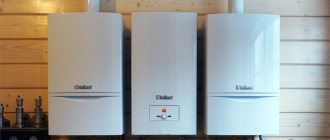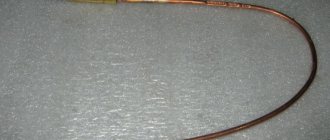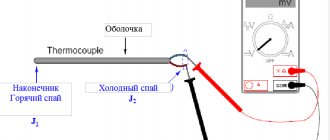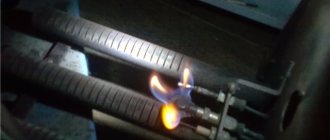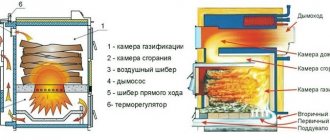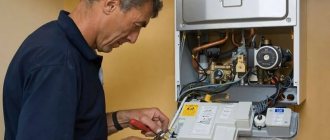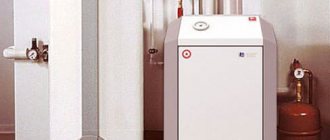Can't find the instructions? Did the recommendations in the brochure not help you? You have the opportunity to read our article about setting up boilers. If you don't know how to handle gas equipment, you need a specialist. But you must admit, it doesn’t hurt to save time and money over and over again thanks to knowledge of the basic settings. Effectively adjusting a gas boiler is much simpler than it might seem.
From the article you will understand the principles of adjusting pressure, thrust and power during operation of the device. Find out the probable causes of problems along with options for eliminating them. If you need to tune the boiler, use our materials. Do not forget about the safety rules, and you will successfully configure the device and fix minor problems.
You should be interested in the settings of a gas boiler long before purchasing, taking into account your needs and various features. We have written which parameters can or should be changed in the device you are using. The new device should be configured and prepared for operation, and some undesirable aspects can be corrected.
How to choose?
What you need to pay attention to when choosing a burner device for a boiler:
- productive power - noise level during operation (applies to supercharged models) - type of heating equipment for which the burner is purchased - type of fuel - pros and cons of this device - provide for possible malfunctions in the operation of the local gas supply line.
Taking these factors into account, you can choose the most suitable burner device for your boiler so that it operates as efficiently as possible without the burden of frequent preventative maintenance.
Combustion chamber of heating equipment
Gas boilers differ primarily in the design of the combustion chamber. It comes in two types:
The open chamber is a fairly simple combustion device. It looks like this: above the burner there is a heat exchanger in the form of a coil of thin copper tubes. Thanks to the open design, the air required for the combustion reaction is supplied to the point of ignition of the gas from the environment.
As a rule, there is enough air from the room (provided good ventilation is organized). But there are wall-mounted models with air intake from outside, for which a special hole is mounted in the wall. Open combustion chambers require a chimney.
Most often it is installed for models of floor-standing gas boilers, and was also used to complete an old-style boiler (in this case, ignition was carried out by a pilot burner).
Combustion chamber design diagrams
The closed combustion chamber is distinguished by the design of the heating block. The heat exchanger is located above the burner. The unit body is closed, combustion air is pumped by a fan installed in the chamber. Coolant is passed through the double walls of the chamber, heating it, increasing the efficiency of the boiler. The gas is burned almost completely, the combustion products are removed by a coaxial pipe under air pressure.
Types of burners
According to their design and functional differences, burner devices are divided into:
By purpose:
- for high power industrial equipment
- for household equipment.
By fuel type used:
- devices for natural gas;
- devices for liquefied gas;
- universal devices.
By flame adjustment:
- single-stage – capable of operating on/off;
- two-stage (as a variation - models with smooth modulation) - operate at full power, when the desired temperature is reached, the flame is reduced by half;
- modulating - boilers with a modulating burner are characterized by smooth adjustment of the flame power.
According to the operating principle:
- injection/atmospheric. They operate by supplying air from the room. They are installed respectively in open combustion chambers. Also used for old-style boiler models.
- fan/supercharged. They work in isolated combustion chambers. Combustion air is supplied by a fan. According to their design features, they are divided into: - vortex (round-shaped nozzle holes) - direct-flow (shape of a narrow slot with a round/rectangular cross-section).
- diffuse-kenetic. Air enters two simultaneously: one is mixed with gas fuel, the second is added directly to the chamber during combustion.
Possible malfunctions when starting the boiler and methods for eliminating them
Failures of gas equipment with electronic controllers can only be repaired by a specialist. If, despite following all the rules, the new gas boiler does not start, the user can independently eliminate the simplest faults.
Cannot turn on igniter
The failure occurs for several reasons:
- the insulator is dirty. To eliminate damage, wipe it with a clean, dry cloth. Heavy stains can be removed with solvents. The element is wiped dry;
- formation of soot deposits in the space between the body and the spark plugs. In this case, no spark appears. You need to tap on the gas supply channel.
If, when the igniter is on, gas does not flow when you turn the knob, there is a risk of problems with the solenoid valve, thermocouple, thermostat or supply valve. These breakdowns are repaired by a specialist.
Advice! If you find a web, you need to unscrew the nut and carefully remove it.
Water does not heat up
The complexity of the breakdown depends on the type of boiler:
- Deposits form on the walls of mechanically controlled contour models. The DHW circuit is washed with hot water and detergents;
- electronic gas boilers do not heat water due to breakdowns of electronics or flow sensors.
Important! Only a professional should troubleshoot electronic equipment.
Clock appears
The failure is typical for devices that heat the coolant at high power.
To prevent the cost of paying for gas fuel and premature wear of the automation, the supply intensity is reduced. You need to adjust it according to the instructions by turning the screw on the valve or using the buttons on the control panel. Correct and consistent activation of the gas boiler will create a comfortable temperature. By following the recommendations of experts, you can easily carry out the first launch of equipment that will be effective in cold and damp weather.
Watch a video on how to properly turn on and start a gas boiler
Gas burner device for a boiler
Atmospheric and fan burner devices differ in their structure. This is due to the different ways in which oxygen is supplied to the chamber during fuel combustion.
Atmospheric burner device.
Air enters the combustion chamber directly from the room. Nozzles are located inside the burner channel. Gas is supplied to the nozzles, mixing with air, which also has access here. At a short distance from the nozzles there are outlet slots through which the finished fuel mixture is supplied. An area of reduced pressure is created between the nozzles and outlets, which promotes a constant supply of air for mixing.
A pilot burner is constantly running in the combustion chamber to ignite the main device.
Fan burner device.
The device block consists of:
- engine;
- fan;
- automatic control unit;
- gearbox;
- air pressure switch;
- fuel mixer.
Air is forced from outside by a fan and supplied to the combustion chamber to form a fuel substance. The air to gas ratio can be adjusted using a damper and a fan.
In what cases is it necessary to adjust the burner flame?
An atmospheric gas burner for heating equipment often fails. It is equipped with models of both wall-mounted and floor-standing boilers. The injection burner of floor-standing equipment reduces its efficiency for various reasons:
- Burner power is too high. This happens when a high-power burner is purchased for small heating equipment. At the same time, there is not enough space for combustion, the air flow for such power is weak, which leads to the transition of the flame from blue to yellow, sooting of the combustion chamber and chimney.
- If the chimney is poorly cleaned, the boiler draft deteriorates. At the same time, waste combustion products are poorly removed, and the air flow is small. This worsens combustion and the flame turns yellow.
- A defect in the burner itself does not make it possible to correctly adjust the complete combustion of the fuel.
- Due to pressure changes in the gas supply system, well-regulated equipment can release large amounts of unexhausted gas into the chimney. Partially it settles with soot and soot. A large layer of soot reduces traction and increases fuel consumption.
- Starting heating equipment after repair.
- The presence of extraneous noise during operation of the boiler or gas burner.
- Changing the type of fuel.
Check before first start
If the equipment is new, then there is no need to check the deposits on combustion products; it is advisable to inspect the ventilation and remove excess debris from the chimney pipe. In these elements, I often noticed the accumulation of various insects, both small and large individuals, they can affect the productivity of the unit.
Open the chimney damper to the limit and check the draft. If you carry out the manipulations as carefully as possible, problems should not arise. But it is better to do all the work sequentially and devote the required amount of time to each moment, do all the work carefully and scrupulously, because safety directly depends on this.
Equipment setup
Floor-standing gas boilers with an atmospheric burner can be configured independently. Pressurized systems are regulated by an automatic control unit and do not require additional configuration.
Scheme of actions for setting up single-stage equipment:
- Install the device on the boiler.
- Connect to the gas pipe.
- Check for absolute tightness.
- Remove the burner housing.
- Using a pressure gauge, measure the gas pressure at the inlet.
- Connect to electricity. Make sure that the jumpers and phases are connected correctly.
- Place a gas analyzer in the chimney pipe.
- Start the device.
- Using a pressure gauge, take pressure readings at the outlet of the burner block. Pressure readings must correspond to the parameters indicated in the data sheet.
- Adjust the air flow using the air damper.
- The gas analyzer readings must also comply with all gas equipment installation standards.
Setting up gas equipment should be carried out by specialists. The simplest open-type boilers can be configured independently if you have certain skills and knowledge of the design of the burner unit. The efficiency of the boiler, its level of efficiency, and fuel consumption depend on the quality of the burner. It is possible to superficially determine that the equipment is malfunctioning by the changed burner flame.
A heating system where the main element is a gas stove is a common type of heating for private households and cottages. There are many things in favor of natural gas as a heat source: high efficiency, environmental friendliness, and the ability to make the heating process fully automated. The fuel itself is also the most inexpensive at present, unless, of course, you take into account wind energy and solar radiation. But these methods have not yet found wide demand due to the unaffordable price of the equipment.
The quality of gas heating depends on how efficiently the gas burner for the stove works.
Homemade units
There are craftsmen who remake heating systems with their own hands. On the Internet you can even find the necessary diagrams for changing the devices of gas burners, their installation and adjustment.
Typically, metal is used as a material for the manufacture of heating systems. A cast iron firebox would be much more reliable. However, it is not possible to use it at home.
An excellent option for manual work is to order the system from specialists. They will be able to manufacture the device in accordance with all the customer’s wishes. However, the possibility of defects in the boilers cannot be ruled out, which may appear after some time.
Why do you need homemade heating units? The fact is that the marked options have a lower cost. They are made mainly because of the desire to save money. At the same time, these options are inferior to their factory counterparts in efficiency.
Usually only solid fuel and electric units are manufactured. Making a gas or diesel boiler is extremely dangerous. In addition, their installation in the house is strictly prohibited.
According to the principle of operation, a homemade product is no different from a purchased version. It will burn fuel and heat the coolant filled with water.
The main disadvantage of this unit is the lack of warranty. Factory equipment will work and perform its functions. Even if the buyer stumbles upon a defect, he will be able to exchange the product for another.
It is better to use pellets, firewood, and coal as fuel in self-made units. These materials are less dangerous than gas. It is impossible to make heating devices based on the latter.
Simple solid fuel units are the most popular and widespread homemade devices. They are simple, and their design is in many ways similar to a conventional stove. In addition, they are versatile.
Like a conventional stove, these systems can operate on any solid fuel. The main thing is that it burns.
Main parts of a gas boiler.
The efficiency of homemade equipment is significantly lower than factory equipment. It is influenced by many factors.
Among them:
- thermal insulation;
- combustion completeness;
- the correctness of the conclusions.
The efficiency of the unit directly depends on the combustion temperature. The higher it is, the lower the efficiency. In high-quality systems, the temperature in the firebox is maintained at 120–150°C. Higher values reduce the safety of pipes. This in turn significantly reduces the durability of the unit.
When manufacturing heating boilers with a burner, it is better to protect yourself as much as possible from the possible consequences of its operation. Therefore, you should consider a separate purchase of an automatic gas burner, which will be installed in an atmospheric or blown boiler.
You can also make electric heating units with your own hands. Their design may vary. It all depends on the person’s needs. The simplest option is to install a heating element directly into the heating system. In this case, there is no need to make a boiler.
The pipe with the heater must have a sufficiently large diameter. It should be easily removable for repairs and cleaning.
Systems without a heater deserve special attention. Its role is played by water itself. A current is passed through it, and heating occurs due to the movement of water ions. The liquid itself must contain salt.
It is extremely difficult to make such a device. Electric current passes directly through the coolant, so the entire system must be reliably insulated.
One of the dangers of this device is electrical breakdown. Essentially the same as a short circuit. Gas may also accumulate in the system. As a result, heating efficiency will decrease.
From all of the above, the best option is a solid fuel unit. Its body can be assembled from heat-resistant steel. It is characterized by increased strength, less wear and high resistance to thermal influences.
However, heat-resistant steel is expensive and in practice is rarely used in homemade boilers. Another option is cast iron: this material tolerates heat well, although it is difficult to work with. Equipment for the manufacture of cast iron stoves is available only at specialized enterprises.
It is important to understand that without the proper experience and skills, it is better not to make a heating system yourself. Safety must come first
It is enough to make even one inaccuracy, and this can lead to disastrous consequences.
Principle of operation
Water circuits are rarely connected to gas stoves. The room is heated directly by heated air from the stove. The only difference with a solid fuel stove is that natural gas is used, not wood.
Advice. It is very easy to install a water circuit with a heat exchanger or a water tank in gas furnaces; sometimes a system is connected that allows warm air masses to be discharged into adjacent rooms.
There are options for gas stoves combined with a solid fuel unit or powered by electricity. There are universal burners that run on diesel fuel if the need arises.
Important. All installation and repair work related to gas fuel must be carried out exclusively by representatives of a specialized organization that has the appropriate permit.
Circulation pump
The boiler circulation pump requires special attention during startup.
Air often accumulates in it, and its blades sometimes seem to get stuck (the boiler will display a corresponding error).
To do this, you need to remove the front panel of the housing, unscrew the central bolt on the pump and use a straight-bladed screwdriver to turn the shaft in the direction indicated by the arrow.
An air vent is installed above the pump. You need to pull the bright lid up and let the air escape.
Floor-standing boilers are usually more powerful than wall-mounted ones. If you need to heat a large room, it is better to choose this option. — overview of design options and models.
Conclusion
At first, the system may make gurgling sounds, all because during startup it is impossible to bleed air down to the last atom. It will gradually be removed through the expansion tank valve. Periodically check the pressure on the pressure gauge - it should be within the operating range.
Temperature adjustment and other boiler settings are described in the instructions for each model.
What types of gas ovens are there?
Gas stoves are used to heat households and country houses, but such devices have gained the greatest popularity in the construction of bathhouses. Most often, for this case, they buy factory-made units that have a metal body. In this case, you need to choose the right model in terms of power and purpose, taking into account the operating conditions. Brick ovens are also being built.
Based on the method of generating heat, furnaces can be divided into two types:
- Having a combustion chamber . The gas enters the heating chamber and, when burned, heats its walls.
- Furnace with heat exchanger . In the designs of these heating units, gas enters a curved, heat-resistant steel tube, which acts as a heat exchanger.
Choosing a burner
Stove gas burners, which are installed in the stove of a household or a country house, are similar to each other. Like a gas burner for a boiler, it has a combustion chamber (heat exchanger), a housing, a smoke exhaust system, channels for heated air and an automatic unit.
However, there is one obligatory part that has its own characteristics in each case - a gas burner for the stove. It is she who is responsible for the efficiency of the heating unit, power characteristics, economical fuel consumption, safe operation and other important parameters.
In a gas burner, the process of mixing gas with oxygen occurs; it contains a control unit for the fuel combustion process. With its help, you can set a specific mode, adjusted to the temperature level required for heating. Boilers and stoves often have the same burner models.
Single-stage atmospheric gas burners for a home stove are not difficult to use, they are easy to install in a heating unit. They don't need electrical power. This burner is placed on the front side, where the combustion door is located.
Important. To select a burner, you need to know its power; it lies in the ability of this model to process a certain amount of fuel in a given period of time.
Recommendations for storage and disassembly
All gas appliances require careful handling and compliance with safe operation rules. Therefore, it is not recommended to repair malfunctions without permission or disassemble the burner and the gas boiler itself.
In order to avoid emergency situations, as well as to ensure the correct and efficient operation of the device, it is best to contact the gas company with which you have a maintenance agreement. Calling a specialist will be the most reasonable decision, because the price of your life and the lives of the people around you is much higher than calling a specialist.
As for storing household gas burners, everything is simple. They must be stored in a dry and ventilated area to avoid corrosion of metal parts.
Make sure that there is no moisture inside your boiler's heating system; if the outlets are rusty, then most likely there is moisture present. If you plan to leave the gas boiler in a garage or other unheated room for the winter, then make sure that these entrances are not closed. What is needed for the natural evaporation of water
To store the boiler itself, you need to make sure that there are no plugs at the outlets for connecting the heating pipes.
You also need to make sure that there is no water inside. If you do not drain the water, the tank will rust and the boiler will be unusable.
What types of burners are there?
If a gas burner is considered from the point of view of the method of controlling thermal power, then all models can be divided into the following categories:
- Single stage . In this case, gas supply (switching off) occurs automatically, based on a rheostat signal.
- Two-stage . The burner has the design ability to switch to an economical mode. This process is regulated automatically.
- Burners with floating adjustment . The burner power can be changed smoothly, from 10 to 100 percent.
Burners are divided according to the method of air supply:
- Atmospheric . In this option, no electricity is needed; air flows to the burner under the natural action of draft. The efficiency is not very high, no more than 90 percent. This is a simple design: a pipe with holes into which fuel is supplied. It works in open combustion chambers. They can be quickly converted, if necessary, to use liquid fuel; the service life of such burners is very long. However, such burners impose increased safety requirements.
- Supercharged . They are also called blower or fan burners. This is a rather complex design. Air is supplied to the burner by a fan; in this case, the combustion chamber is closed. Efficiency exceeds 95 percent. Stoves with such burners do not require bulky chimneys. At the same time, the furnace operates stably even at low gas pressure. However, they produce a lot of noise and are volatile.
- Diffuse-kinetic . The air is partially pumped into the combustion chamber, the rest is supplied directly to the flame.
Important. In capital devices with high heat capacity, at high furnace power, the burner can overheat. It is recommended to install a model that is resistant to high temperatures.
Bypass valve
If the batteries in the room warm up unevenly, then it is necessary to increase the speed of the coolant. To do this, the bypass screw is turned clockwise.
If, when the heating is turned on, the liquid in the radiators begins to make noise, this is a signal to reduce the speed of the coolant. This is done by rotating the screw in the opposite direction. To set up and measure, you need to use a pressure gauge or digital differential pressure gauge. It will indicate the nominal pressure, which should not be more than 0.2-0.4 Bar.
Ignition type
All burners can be divided according to the type of ignition:
- Electronic type . They do not have a constantly working igniter. Requires electricity to operate. Electric ignition is one of the most convenient inventions for modern heating units. Thanks to him, the operation of the stoves has become as comfortable as possible. Electric ignition makes it possible to light the burner flame safely, without using available wicks or lighters.
- Burners with piezo ignition . No electricity needed.
Sometimes special working conditions are required, for example, burners are placed in a sauna stove, which must distribute the flame well. These are dividers or ordinary distribution tubes. This is how kitchen gas ovens work.
Types of gas burners
Gas boilers differ in the type of combustion chamber. There is an open firebox - which must be equipped with a chimney to remove combustion products. The air for the combustion process in an open firebox comes from the environment. Therefore, units with such a combustion chamber are installed in a specially dedicated combustion chamber.
Gas boilers with a closed firebox differ from the open version. The burner is located inside a closed housing. The supply of air to the burner and the exhaust of smoke to the outside is ensured by a small coaxial chimney.
Gas burners are distinguished by the type of fuel on which they operate:
- for natural gas;
- for liquefied fuel;
- universal.
Most gas boilers are equipped with a universal burner that can operate on both natural and liquefied fuel.
Based on the number of power levels, burner devices are divided into:
- single-stage – capable of operating in only one mode;
- two-stage - have two power levels;
- modulation - capable of smoothly adjusting the flame strength in several modes.
How to set up a gas burner?
It is recommended to adjust the gas boiler burner flame using a gas analyzer. It records indicators of the air that participates in the process of fuel combustion: CO concentration, oxygen level, excess air ratio. The CO concentration should not exceed 50 ppm; oxygen is normally in the range of 3.6-5.3%. A lower oxygen content will lead to incomplete combustion of the fuel, a higher oxygen content will lead to a high concentration of CO2. Excess air can lead to an explosive situation, and its lack can lead to incomplete combustion of fuel, the formation of soot, soot and low efficiency.
The intensity of the fire can be observed through the viewing hole. The orange flame is too large, you can reduce it until it becomes almost invisible and has a bluish tint. Such a fire ensures optimal operation of the gas boiler. If you reduce the flame further, it will become completely invisible and then go out.
Regulation of the starting fuel supply works only at the moment of ignition and does not affect the operating efficiency. But if desired, it can also be adjusted: it is necessary to gradually reduce the starting flow, turning on the burner until it stops lighting up; then you need to increase the starting feed by turning the regulator in the opposite direction. The setup ends with checking that the burner is turned on.
If the flame burns with noise, you should reduce it using the regulator.
Why does a gas boiler smoke - reasons and solutions
GENERAL OCCUPATIONAL SAFETY REQUIREMENTS
1.1. An employee who is at least 18 years old, who has undergone a medical examination and has no contraindications for health reasons, who has the necessary theoretical and practical training, who has completed introductory and initial workplace safety briefings and training according to a special program, and who is certified, is allowed to perform work using a gas burner. qualification commission and received permission to work independently. 1.2. An employee who performs work using a gas burner (hereinafter referred to as the employee) must periodically, at least once a year, undergo training and testing of knowledge of labor protection requirements and receive permission to perform high-risk work. 1.3. An employee, regardless of qualifications and work experience, must undergo repeated training on labor protection at least once every three months; If an employee violates labor safety requirements, as well as during a break in work for more than 30 calendar days, he must undergo an unscheduled briefing. 1.4. An employee who has not undergone timely instructions and testing of knowledge of labor protection requirements is not allowed to work independently. 1.5. An employee performing work using a gas burner, who is allowed to work independently, must know: safety measures when using gas cylinders and burners. Rules, regulations and instructions for labor protection and fire safety. Rules for the use of primary fire extinguishing agents. Methods of providing first aid in case of accidents. Internal labor regulations of the organization. 1.6. An employee sent to participate in work unusual for his profession must undergo targeted training on the safe performance of the upcoming work. 1.7. An employee is prohibited from using tools, devices and equipment that he has not been trained in the safe handling of. 1.8. When performing work using a gas burner, an employee may be exposed mainly to the following dangerous and harmful production factors: - the possibility of a fire when using a gas burner; — the possibility of a gas cylinder explosion; — gas burner surfaces heated to high temperatures; - uncomfortable working position. 1.9. An employee performing work using a gas burner must be aware that during work, the most likely cause of injury may be burns from the open flame of a gas burner. 1.10. To protect against the effects of dangerous and harmful production factors, the employee must use special clothing, safety shoes and other personal protective equipment. 1.11. To prevent the possibility of a fire, the employee must comply with fire safety requirements himself and prevent other employees from violating these requirements; Smoking is permitted only in designated areas. 1.12. The employee is obliged to comply with labor and production discipline, internal labor regulations; It should be remembered that drinking alcohol usually leads to accidents. 1.13. If an accident occurs with one of the employees, the victim must be given first aid, report the incident to the manager and maintain the situation of the incident, if this does not create a danger to others. 1.14. The employee, if necessary, must be able to provide first aid and use a first aid kit. 1.15. To prevent the possibility of illness, employees should observe personal hygiene rules, including thoroughly washing their hands with soap before eating. 1.16. It is not allowed to perform work while intoxicated or in a state caused by the consumption of narcotic drugs, psychotropic, toxic or other intoxicating substances, as well as drink alcoholic beverages, use narcotic drugs, psychotropic, toxic or other intoxicating substances at the workplace or during work. time. 1.17. An employee who violates or fails to comply with the requirements of labor safety instructions is considered a violator of industrial discipline and may be subject to disciplinary liability, and, depending on the consequences, to criminal liability; if the violation is associated with causing material damage, then the perpetrator may be held financially liable in the prescribed manner.
Converting the burner to another type of gas
Only universal burner devices can be easily adapted to another type of fuel and do not require replacement of component parts. To switch to a different type of gas, the remaining burners need to replace the ramp, diaphragm, nozzles or manifold. Using the ramp, you can regulate the gas supply over a fairly wide range. In some cases, it is possible to adjust a burner operating on one type of fuel to burn on another type of gas. For example, switch from propane to methane and vice versa. When replacing propane with methane, the starting flow is first increased to ignite the gas, and then gradually reduced, as detailed in the previous section.
When switching to propane during initial startup with maximum fuel supply, a methane burner will smoke. It is adjusted by gradually reducing the fuel supply.
When converting a burner device from one type of fuel to another, it should be taken into account that the specific heat of combustion of propane is 1.5 times greater than that of natural gas - methane. So the power of a methane burner running on propane without replacing elements will increase. For example, a gas boiler with a power of 10-30 kW, when converted to propane, is capable of delivering a performance of 15-45 kW. However, the burner will not be able to produce more than 30 kW for a long time, as it will quickly overheat and fail. Therefore, the operating power range of the unit will be 15-30 kW.
When converting a similar boiler from propane to methane, the power will decrease and amount to 6 -18 kW.
Characteristic
An acetylene welding torch is a special device into which a special gas (acetylene) is supplied for combustion. It is used more often than other devices for gas welding. The reasons for its popularity are quite obvious:
suitability for work even with a limited set of equipment;
high efficiency of application (justified even at nuclear and other critical facilities).
The combustion temperature of acetylene is higher than that of any other welding gas. It reaches 3200 degrees. The reason is that the acetylene combustion reaction is endothermic, while other gases absorb heat during the decomposition process. Complete combustion of 1 cu. m of this gas will require the use of 2.5 cubic meters. m. air. These are the calculations carried out by chemists based on the formulas of the reacting substances.
However, in practice, acetylene burns only incompletely in a flame, so during real welding the air consumption does not exceed 1-1.2 cubic meters. m. Because of this, the total useful heat productivity, instead of the theoretically calculated 13500 kcal per 1 m3, is only 5120 kcal per 1 m3. In practice, an oxygen-acetylene mixture is most often used, in which 55% is acetylene, and the remaining 45% of the mass is oxygen.
It is also useful to understand how an acetylene torch differs from a propane torch in practice. The first type is mainly used for working with relatively thin (no more than 6 mm) metal. The tips of the burner devices contain, in addition to the injector, also a mouthpiece and a tube. The proportions of the holes in the mouthpieces and injectors are calculated strictly individually for each gas used. Therefore, to replace the gas, you have to use a different tip, preferably from the same manufacturer.
